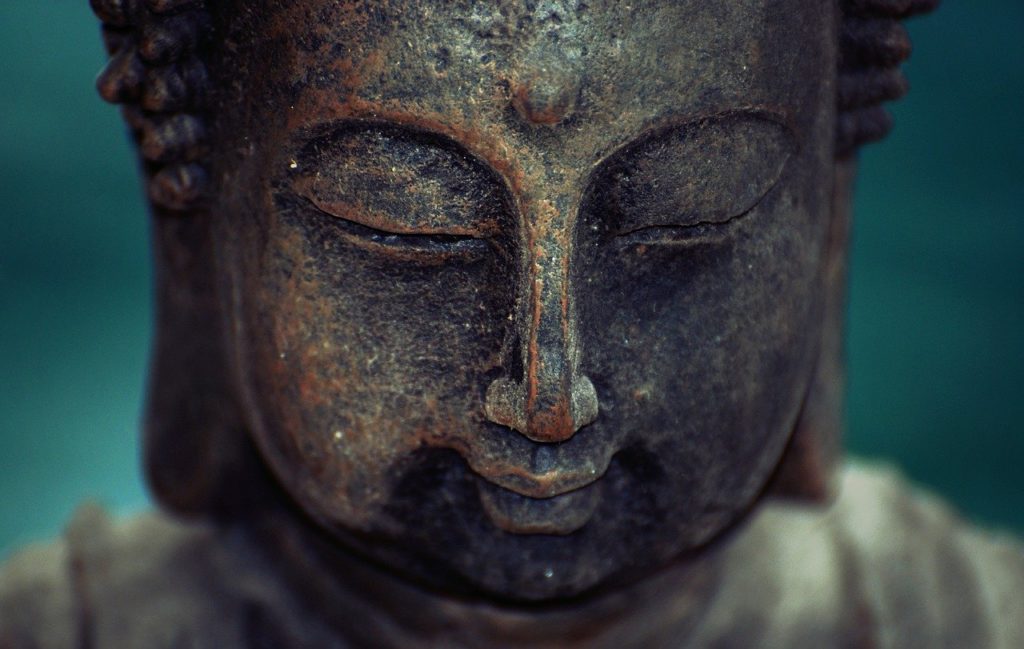Wouldn’t it be great to feel content and at ease with things just as they are?
Imagine the ability to not come undone with the multiple stressors in our lives. Especially right now when there are PLENTY. Or what if you could shake that feeling that if only you could get paid more, or have a better house, or the perfect body, that everything would be okay?
The problem with that line of thinking is the belief that achieving some sort of elusive external satisfaction will make you happy. In reality, contentment is an inside job.
In yoga, this is called santosha.
What Is Santosha?
Before we delve into this important ethical precept, we want to make clear that the challenges the vast majority of us face are real. And for some, there are VERY legitimate concerns and worries at the helm right now.
Santosha is not some sunshiny Pollyanna concept chirping an annoyingly cheerful “just be content” in your ear. If you’re trying to figure out how to feed your kids or save your home, how could you possibly hear that?
Rather, santosha asks us to focus on the present in order to feel satisfaction in what we do have. It’s that inner feeling of peace and contentment that overpowers the external challenges that unhinge us.
Some might call this faith. It’s faith not in a power outside ourselves though, but in our own innate ability to be at peace.
Of course, this is much easier said than done. Especially when life has been thrown into chaos. Yet, santosha also asks us to look at how much of the chaos we bring on ourselves.
Do You Really Want to Know How to Feel Content?
Sounds like a weird question, but think about it for a minute. How often to do you swap out feeling content for something more active or seemingly exciting?

For example, you get your dream job and it’s everything you imagined it would be. But a month later, you’re already searching for something more exciting. Or perhaps you’re single and longing for a relationship. When you’re in one though, you crave freedom.
You may even find ways to fill up free time with chores and tasks rather than enjoy the peace of the moment that’s opened up to you. It’s as if contentment is just too dull or boring. Or perhaps it’s more that you feel like a slacker when you take advantage of these moments. You’ve given into the belief that unless you’re constantly achieving goals and desires, you’re nothing more than a slug.
Yet, if you’re never willing to settle into santosha and contentment, you can’t know peace.
It’s Okay to Have Goals and Desires
The problem with concentrating on ONLY goals and desires though is the attachment and sense of comparison that come with them. You expect a new job to be a certain way and when it’s not, you’re disappointed. Or you compare your body to someone else’s and feel like a failure if you can’t achieve the same.
This isn’t to say that having goals or striving for something is inherently bad. But when the focus is on only a positive outcome, the result is failure and inadequacy if that doesn’t happen. So much for contentment.
Santosha, on the other hand, encourages us to simply do our best and leave the rest up to the universe, as it were. It does NOT dictate in any way that we don’t feel grief or sadness when something doesn’t work out. It simply asks that retain our inner balance and try to be open to what’s coming next.
Contentment is the ability to stop looking outside yourself for happiness. It’s looking at your imperfect life, acknowledging the little graces, and being okay with it just as it is.
And that takes practice.
How to Feel Content in Your Everyday Life
Yoga, meditation, and other mindfulness practices place tremendous value on santosha and employ techniques to help you find it. At the foundation of all of this though, you just need remember this one simple fact:

Contentment grows out of gratitude.
In other words, the more grateful you are, the more content you will feel. You can start by keeping a gratitude journal. It may sound hokey, but get in the habit of scrawling out (or typing into your phone) five to ten things about which you’re grateful each day.
Doing so with regularity will help you get into the habit of looking for things you can jot down the following day. Then after a few days, you’ll begin to notice actions, events, people, or things that you’ll want to put in your journal. And soon enough, you’re taking a little longer to enjoy the color of a flower, the trusty nature of your car, or the words of the barista who serves you coffee each day.
Another (or additional) option is to say out loud three things for which you’re grateful before you eat a meal. Again, these could be big things like the love of a child, or small things like a poppy seed bagel. Encourage your dining partners to do the same and it’ll enable you to start seeing even more.
Practicing gratitude may seem simple and even mundane. But it’s powerful. And it’s easy. So why not give it a try? You have nothing to lose and contentment to gain.
Looking for More Contentment in Your Life?
As we said before, learning how to feel content starts with gratitude and continues with practicing.
If you’re curious about adding yoga, mediation, life coaching, or other mindfulness practices to your life, we can bring them right to your business, organization, or school.
Contact us to learn about our programs. We offer both in-person and virtual sessions to help you and your co-workers feel more content!



